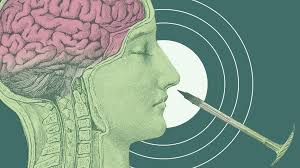Contents
Introduction
Lobotomy, once hailed as a revolutionary treatment for severe mental illnesses, is now regarded as a stark reminder of the ethical complexities inherent in medical practice. Developed in the early 20th century by neurologist António Egas Moniz and popularized by Dr. Walter Freeman, lobotomy promised relief from psychiatric disorders through the disruption of neural pathways in the brain’s prefrontal cortex. However, the procedure’s widespread adoption was accompanied by profound ethical concerns, including coerced consent and inadequate follow-up care. Despite its decline with the advent of alternative treatments, the legacy of lobotomy endures as a cautionary tale, prompting ongoing reflection on the intersection of science, ethics, and the pursuit of cures.
The Origins of Lobotomy
The term “lobotomy” evokes a chilling chapter in the history of medicine, where the quest for mental health cures took a controversial turn. Introduced in the 1930s by Portuguese neurologist António Egas Moniz, the lobotomy was hailed as a revolutionary treatment for severe mental illnesses. Moniz believed that by severing connections in the brain’s prefrontal cortex, he could alleviate symptoms of conditions like schizophrenia and chronic depression. The procedure quickly gained traction, especially in the United States, where Dr. Walter Freeman became its most infamous advocate.

The Rise of Lobotomy in America
Freeman’s “ice pick” method, which involved inserting a leucotome through the eye socket, was performed on thousands of patients. Initially, lobotomies were celebrated for their apparent success in reducing extreme agitation and emotional distress. However, the consequences were often devastating. Many patients were left in a vegetative state, suffered severe cognitive impairments, or experienced dramatic personality changes.
Ethical Concerns and Controversies
The ethical implications of lobotomy are profound. Consent was frequently coerced or entirely absent, particularly in vulnerable populations such as women, minorities, and institutionalized patients. The procedure’s irreversible nature and the lack of comprehensive follow-up care highlighted significant ethical breaches in medical practice.
Furthermore, lobotomy was often used as a means of controlling behavior rather than treating underlying mental illness. Patients who were deemed difficult or disruptive were subjected to the procedure without sufficient consideration for their well-being or autonomy. The practice also disproportionately targeted marginalized groups, reflecting broader societal biases and injustices.
The Decline and Legacy of Lobotomy
As the adverse effects of lobotomies became more apparent, and with the advent of antipsychotic medications in the 1950s, the practice began to decline. Lobotomy’s legacy serves as a stark reminder of the importance of ethical standards in medical research and treatment. It underscores the need for rigorous scientific validation and respect for patient autonomy in the pursuit of medical advancements.
The history of lobotomy is a poignant example of how the search for cures can sometimes lead down dark paths. It challenges us to balance scientific innovation with ethical responsibility, ensuring that the well-being and rights of patients remain at the forefront of medical practice.

Lessons Learned and Moving Forward
While the era of widespread lobotomy may be behind us, its legacy continues to inform contemporary discussions surrounding mental health treatment and ethical medical practice. It serves as a cautionary tale about the dangers of prioritizing expedience over patient well-being and the importance of critically evaluating the efficacy and ethical implications of medical interventions.
Moving forward, it is essential to approach mental health treatment with humility, compassion, and a commitment to upholding the highest ethical standards. This requires ongoing dialogue, research, and advocacy to ensure that individuals with mental illness receive evidence-based, humane care that respects their autonomy and dignity.
Conclusion
The story of lobotomy is a sobering reminder of the complexities inherent in the intersection of science, ethics, and medicine. While it may represent a dark chapter in medical history, it also serves as a catalyst for reflection and action, driving us toward a future where mental health treatment is grounded in compassion, respect, and the relentless pursuit of genuine cures.



